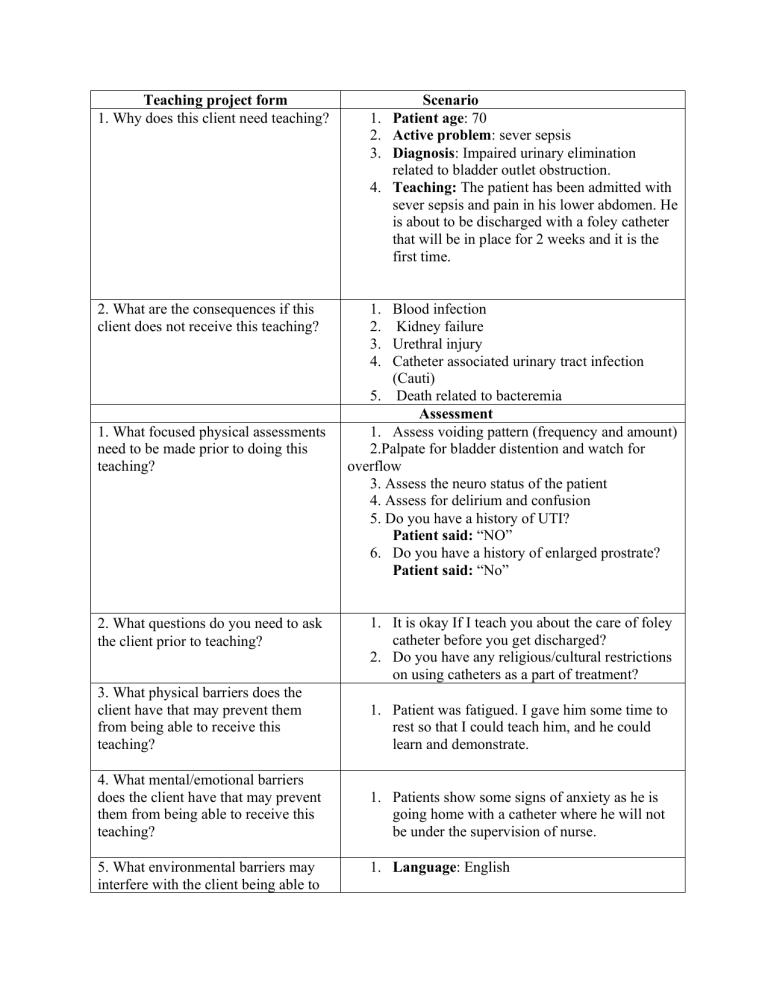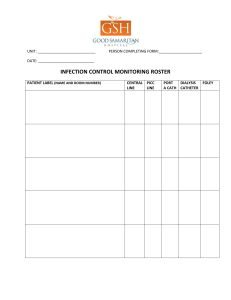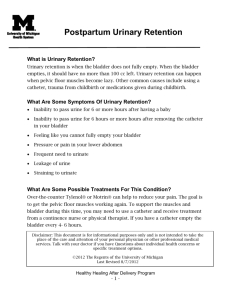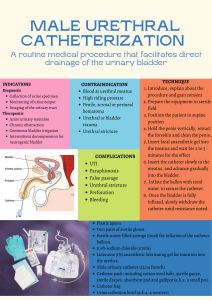
Teaching project form 1. Why does this client need teaching? 1. 2. 3. 4. 2. What are the consequences if this client does not receive this teaching? 1. What focused physical assessments need to be made prior to doing this teaching? 2. What questions do you need to ask the client prior to teaching? Scenario Patient age: 70 Active problem: sever sepsis Diagnosis: Impaired urinary elimination related to bladder outlet obstruction. Teaching: The patient has been admitted with sever sepsis and pain in his lower abdomen. He is about to be discharged with a foley catheter that will be in place for 2 weeks and it is the first time. 1. Blood infection 2. Kidney failure 3. Urethral injury 4. Catheter associated urinary tract infection (Cauti) 5. Death related to bacteremia Assessment 1. Assess voiding pattern (frequency and amount) 2.Palpate for bladder distention and watch for overflow 3. Assess the neuro status of the patient 4. Assess for delirium and confusion 5. Do you have a history of UTI? Patient said: “NO” 6. Do you have a history of enlarged prostrate? Patient said: “No” 1. It is okay If I teach you about the care of foley catheter before you get discharged? 2. Do you have any religious/cultural restrictions on using catheters as a part of treatment? 3. What physical barriers does the client have that may prevent them from being able to receive this teaching? 1. Patient was fatigued. I gave him some time to rest so that I could teach him, and he could learn and demonstrate. 4. What mental/emotional barriers does the client have that may prevent them from being able to receive this teaching? 1. Patients show some signs of anxiety as he is going home with a catheter where he will not be under the supervision of nurse. 5. What environmental barriers may interfere with the client being able to 1. Language: English receive this teaching? (Think about environment barriers IN the hospital at the time of the teaching) 6. What environmental barriers may interfere with the client being able to continue this teaching when they leave the hospital? (Think about environmental barriers AT HOME after teaching) 7. What personal strengths does the client have that will help him to accept and follow the teaching given? 8. What personal weaknesses does the clients have that may make it difficult to accept and follow the teaching given? Patient does not have any communication barrier 2. Tv is loud, and frequent interruption from care provider because he is ready for discharge. 1. Inability to get proper type of catheter may be one reason that interfere the client to discontinue the teaching. 2. Inadequate facilities in public toilet for caring out safe catherization. 3. Lack of privacy that patient felt embarrasses and uncomfortable. 1. Ready to learn: Patient stated that he is ready to feel better and wants to know all he can do to improve his condition this evidence readiness to learn self-care practice. 1. Patient does not show any kind of weakness that prevents him from learning. He is excited to learn and feel better in the coming days. Teaching Plan 1. What equipment, instructional aids, and media should be used for this teaching session? (Be specific about what information will be expected on each of your resources or how it will add to your teaching session) 2. Why are these tools appropriate for this specific client? 3. What collaborative care team members can you work with to carry out or reinforce this teaching? 4. Will the client require any equipment or tools when they go home to be able to carry out this teaching? 1. One-on-one teaching: - affective, cognitive 2. Demonstrate skill: - psychomotor 3. Printed and audiovisual method: - cognitive 1. One on one teaching helps patients to have privacy during catheter care discussion. 2. The patient will demonstrate how he is going to empty the drainage bag properly. 3. Patients will use this information as a reference when at home to remember the teaching at hospital. 1. Charge nurse 2. primary nurse 3. Discharge planner 1. Patient need written information about how to care for catheters. 2. Catheter bag holder 3. A leg bag on the correct size with straps. 5. Will anyone aside from the client (i.e., family) need education to help support the client after discharge? How can you include family members or those close to the client in the teaching session? Yes, Patient wife 1. Helping patient’s wife to practice caring for catheter on the ward prior to discharge. 2. Educating the patient’s wife about the importance of well-hydration and the need for fiber food to avoid dehydration and constipation. 3. Educating the patient's wife to prevent or remove kinks in the catheter. 4. Educating the patient’s wife to watch out for the complications and get immediate professional help when needed. 6. Outline a summary of your teaching plan including 3-5 specific teaching points you will incorporate during your teaching session. 1. Daily fluid intake 3-5 liters a day to prevent bladder infection. 2. Egg, cheese, meat, and cranberry to reduce the risk of urinary tract infection. 3. Use hand hygiene during manipulation of the catheter to prevent infection. 4. Drainage bags should be kept below the bladder, should not be kinked, and should not touch the floor. Goals 1. What are 2-3 teaching goals (must be SMART) you want to include in the teaching session? These should be specific and appropriate to the specific client you are teaching. (Example: Client will state three foods to avoid by end of the teaching session) 1. Patient will state how to keep the foley catheter including hand hygiene, avoiding the kinks, how to empty the drainage bag and how to keep the bag below the urinary bladder before discharged. 2. Patient will state which food is used to acidify the urine and important to acidify the urine by the end of teaching season. 3. Patient will state the requirement and importance of 3-5 liters of fluid intake throughout the day by the end of teaching season. 4. Patient will state their understanding when to contact doctor by the end of the teaching season. Evaluation 1. For each of the teaching goals above Write specifically how you will evaluate each goal. 1. Patient showed proper draining of the bag using hand hygiene, keeping tubing straight Think about what specifically the client will say or do that will tell you the teaching was effective. (Example: Teach back, demonstration) Evaluation must be measurable (a.e., it should not state “The client will understand...”) 2. 3. 4. 2. When would you have opportunities to reinforce this teaching to the client? How will you reinforce this teaching to the client? 1. 2. 3. 4. and keeping the bag below the bladder before discharge. Patient verbalized that he should eat can berry juice, cheese, egg, and meat to help acidify the urine which helps prevent infection by the end of teaching season. Patient verbalized the understanding that he will need to have 3-5 liters of fluid a day to prevent infection by the end of teaching season. Patient verbalized understanding that he will report to doctor immediately if there is any blood in urine, cloudy urine, and difficulty in draining the catheter to prevent infection by the end of teaching season. Do perform peri-care with soap and water only. Always flush the bag with tap water using syringe to prevent infection. Avoid caffeinated drinks. They irritate the bladder. Complete all the antibiotics prescribed by the doctor even if you feel better.




